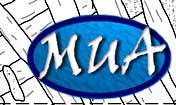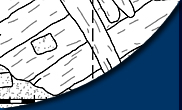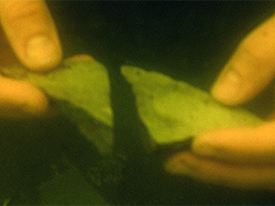
Underwater photo of student recovering two pieces of Olive Jar that still fit together!
After a relaxing weekend the crew returned to the barge for what looked to be a beautiful day of diving. In the morning we were visited by a reporter and photographer from the Pensacola News Journal. Other than the occasional pause for a quick picture, we stuck to our planned dives and continued excavating. Teams 3 and 4 set out for the B-Street Schooner where they set up a baseline across the site. The rest of the teams remained on EPII. Teams 1 and 5 worked on the amidships unit where they continued to work their way through the seemingly endless layer of ballast. Teams 2 and 6 have exposed most of the hull in the stern unit. Partway through the day the weather began to take a turn for the worse. Strong wind, large rolling waves and a strong current made the last two dives a little tricky. When the lightning started, we all hopped on the boats and headed back to shore. After returning to the Marine Services Center the crew began carefully picking through the dredge spoil for anything interesting. We found a variety of interesting objects including tiny bones, resin, pottery sherds, obsidian flakes and a possible coin.
Artifacts recovered from dredge spoil.
Tuesday turned out to be a much calmer day than Monday had been. We had 7 people working out on the barge on EPII, 4 at the B-Street site, and 2 in the lab. The B-Street crew used the baseline to triangulate the points to open up the first excavation unit. After doing so, they were able to begin dredging. The site is mostly soft sand and shells at this point, nothing like the sediments on EPII site which consists of mud, silt, and clay. The students in the lab were all combination underwater and terrestrial archaeology students who had only one more chance to be in the lab before they shifted over to terrestrial for the remainder of the summer. They worked on the artifacts retrieved by students in last year’s field school. The barge students worked at setting up the dredges, and then they dredged for a good hour or so. The amidships unit is getting deep, as the ballast is getting bigger and each giant rock they remove leads them to an even deeper hole with even bigger rocks. The day they hit hull timbers will be a great day (that is, until an adjacent unit is opened and the whole process begins again!). The stern unit on the other hand is almost completely finished now, with only a few more centimeters of ballast and mud to go. What we are finding now are mostly broken pieces of wood, or tiny splinters of wood mixed with sand and silt, which makes it impossible to distinguish when we’re fanning it into the dredge. The ship structure is almost fully exposed, and the only place left to uncover is the space between the frames. Over all it was a good day. The weather held out and everyone was able to dive at least once.
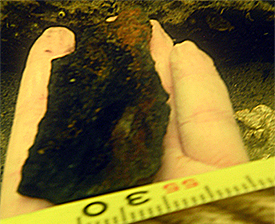
A piece of burnt wood collected Monday at the B-Street Site.
On Wednesday, most of the crew went to the barge along with a film crew from UWF. The film crew was there to get some footage to post on UWF’s website. Those who stayed on shore went to the lab for the day where they measured, sketched, and recorded artifacts recovered from EPII. The students who dove on EPII were split up differently today. The combination students, who will be switching to a terrestrial field school for the rest of the summer, were put into survey crews. They were taught how to use the metal detector and to conduct a systematic search of the site for any anomalies. This was the method being used on EPI when a large concretion was recovered which turned out to be a breastplate. The rest of the students were put into teams to continue dredging in the two open units. The teams in the amidships unit are still working their way through ballast with a few artifacts scattered throughout. The teams in the stern unit have completely uncovered the hull within the unit. At the end of the day, a possible silver bead was recovered from the dredge spoil from the stern unit. This unit will be closed and a new unit will be opened directly to the south next week.
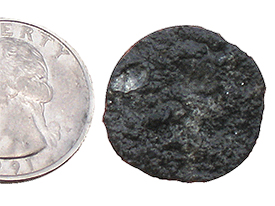
A sixteenth-century coin recovered by students working the in the southern stern unit.
Since Friday is a university holiday in observation of July Fourth, we used Thursday to take a field trip and have a cookout. We spent the morning cleaning the Marine Services Center, repairing grid material, inventorying crew boxes and doing general organization for the project. When we finished cleaning, we drove to the Naval Live Oaks Visitor Center in Gulf Islands Natural Seashore. The park exists because for centuries, it has been a prime location to harvest oak timbers for ship construction. The live oaks grow in such strange twisted ways, with thick trucks and huge branches, that it’s ideal for the creation of equally odd shaped ship parts. As opposed to bending a piece of wood with steam or water in order to shape it, shipwrights would search the woods for a tree that was shaped exactly as the part they were going to build. It was stronger and sturdier than any man-made shape, and some suggest it may even last twice as long. We took a tour of the area, noting the odd shapes that could easily be turned into ship structure, and then it was time to eat. After eating enough food to feed an army, it did not take long for us to roll away from the picnic tables and into the water. You would think that a bunch of people who spend most of their time in the water would try to get away from it as often as possible, but as long as there is a volleyball involved along with an occasional stingray or two, we did not mind too much.
At the end of the day we said our goodbyes to the 5 Combo students, wished them luck in terrestrial field school, and are looking forward to meeting a new round of divers eager to start on Monday. All in all, it was a great way to kick off the July Fourth weekend.
Please feel free to contact us if you have any questions or concerns at: mua@keimaps.com.
Return to Project Journal home page.
